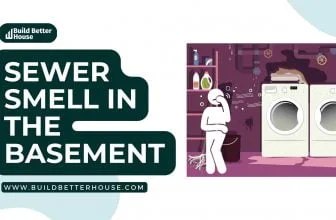Important Tips On How To Prevent Mold in The Basement

When you think of mold, you probably think of humid basements. Mold thrives in damp environments, so it’s not surprising that many people find molds in the basement. Usually, dark, cool, and moist surroundings offer ideal conditions for mold in the basement to grow
There is an adage that when you see mold growing in your basement, something is wrong above ground!
Basements are prone to moisture because they are much lower than the rest of the house. More often than not, your basement will have some moisture problems.
There are various ways to reduce condensation and prevent humidity from building up in your home. The simplest way is by installing a dehumidifier in your basement. A dehumidifier will suck up excess moisture, containing mold spores and other bacteria growth.
How Does Basement Mold Spread?
Mold can spread from the basement to other areas of the house in a few different ways. The most typical scenario is for the mold to grow covertly beneath the carpet or inside the walls. The spores will eventually travel from the initial spot to other close-by areas due to time and growth.
The air conditioner or heater is a second-way mold that can spread from the basement. Air currents move spores from their original place and disperse them throughout the rest of the house. As a result, mold may grow in the air ducts and gradually spread throughout the upstairs of the house.
Your Basement And Home Mold
Spores can develop on wood, carpet, and concrete, which are dark, moist, and present.
Additionally, the basement does not receive the same level of cleaning as the rest of the house, allowing prolonged mold growth to go unnoticed.
Every time you perform sump pump maintenance and cleanings, we advise monitoring locations where mold frequently forms and will allow you to inspect areas like the sump basin and drain mold lines several times a year. To safeguard your health, you must act if you notice mold forming (even in a little patch).
Does Basement Mold Affect The Upstairs?
Yes, mold spores forming in the basement can impact the health of those who live upstairs. Mold can quickly spread to surrounding areas and eventually begin to develop in the basement ceiling and throughout the property.
Mold spores from the basement can be blown into the HVAC system and air ducts and spread throughout the house by air conditioners. These mold and mycotoxin spores can cause various health issues, including respiratory problems!
What Distinguishes Grey Mold From Black Mold?
Black mold and grey mold are two types of mold that often grow in basements and other damp areas. The color difference is due to their environment. Both of these species of mold can be harmful if you breathe in the spores, so removing them from your home is essential.
Grey mold is seen in areas of high humidity, such as humid basements, whereas black mold is found in dry and moist environments but tends to thrive in areas with high humidity. While black and grey mold is harmful, black mold is more toxic than grey mold because it produces more spores.
Types Of Mold In The Basement
Since different types of mold have other characteristics, identifying what kind of mold you have can help you determine the best way to remove it.
- Black mold – The most typical mold in basements. It grows as thin, velvety patches that can appear almost black. Black mold in basement is toxic, making you sick if exposed to it.
- Grey mold – This type of mold is a fungus but not toxic. It grows in areas of high humidity and can find in many basements.
- Water damage mold –This mold is a type of bacteria that grows in water-damaged areas. It can appear as a thick, black, gooey substance and emits a bad smell. Water damage mold is toxic but can be removed easily with a thorough cleaning.
These are the most common types that can distinguish mold by color, shape, and odor.
How To Get Rid Of Black Mold In The Basement?
The best way to get rid of black mold in the basement is to dry out the area as quickly as possible. Black mold thrives in warm, humid places, so the longer it is in your basement, the worse it will get.
If you discover black mold, the first thing you should do is stop the source of moisture. Repair any leaks in your basement, fix broken pipes, and turn off any heads of excess water, such as a humidifier.
Next, you should dehumidify the area. If your basement is highly humid, consider installing a whole-house dehumidifier. You can also buy smaller units for smaller spaces, such as closets or bathrooms.
How To Get Rid Of Grey Basement Mold?
The best way to get rid of the grey mold in the basement is to clean the area thoroughly and dry out the site.
First, use a high-quality broom to remove any visible mold spores. Then, scrub the area with a bleach solution. You should use 2 cups of bleach per gallon of water to kill any remaining mold spores.
After cleaning the area, you must dry it out. If you don’t, the mold spores will return. To dry your basement, open the windows. It would help if you also run fans to circulate the air and speed up the drying process.
Mold In The Basement: Ways To Tackle
Mold is a fungus that thrives in humid environments with little light and airflow. Basements are perfect for mold growth, especially if they have plumbing leaks or other water sources nearby. Mold spores can find almost anywhere, but some thrive in humid areas.
Mold in the basement can spread quickly and cause severe problems if left to grow under. If you have mold in the basement, it could indicate a more significant problem and create an unhealthy environment for you and your family. Here are some ways to assist you in dealing with mold in the basement:
Install a Humidifier
One of the easiest ways to prevent mold growth in the basement is by installing a humidifier. Humidifiers add moisture to the air by spraying water into the air. This will prevent condensation in your basement, which can lead to mold growth.
Humidifiers can also be helpful if you have allergies or other conditions, like asthma, exacerbated by dry air. You can also control the humidity in your basement by adjusting your air conditioner or furnace.
This will vary depending on the model of the system you have in your home, so be sure to check the manual.
Repair the Source of Water
A leak in your plumbing can lead to severe issues, not only in the bathroom above but also in the basement below. If there is a leak, it is best to repair it as soon as possible.
Fixing leaks can be a big job, but it will be worth it; if it prevents mold in the basement from growing in your basement. If you notice a musty smell in your basement, it could signify a leak in your pipes.
You may also see standing water in your basement. If you notice any of these, you may leak your plumbing.
Increase Ventilation
It can thrive mold in the basement if you have a water source. You can mitigate this effect by increasing ventilation in your basement. You can also open your basement windows during dry, windy days.
Consider installing a dehumidifier in your basement. You can use it to control the humidity in the air, and it will also help eliminate any mold in the basement that may be growing.
Use Baking Soda and Bleach
If you have a tiny mold in the basement, you can kill it with baking soda and water. First, mix one baking soda and one part water to create a paste. Clean the mold with a rag, and let it sit for a few hours. Once mold in the basement is dried, you can remove it with a vacuum.
For more challenging jobs, mix two parts of water with one aspect of bleach. This solution will kill the mold and remove stains caused by mold. Avoid getting the key in your eyes since it can irritate them.
Install a Dehumidifier
If your basement has a water source, you may have a higher-than-normal humidity level in the air. This is terrible news for your basement because it can lead to mold growth. A dehumidifier can control the humidity in your basement, reducing the risk of mold.
You can also look for a dehumidifier that filters the air. These models can remove particles that can lead to allergies and asthma. They can also help keep the dust out of your home.
Get a Professional Inspection
If you’ve already tried everything on this list and still have mold-in basement issues in your basement, it might be time to call in a professional. While you may think you’ve fixed the problem, there could be issues you don’t see.
A professional can find issues you may have missed and fix them before they become more significant problems. A professional may also be able to find the root cause of the water source in your basement. This can help you prevent future issues.
Install an Effective Fan and Ventilation system
You’ll want to make sure you’re moving the humid air out of your basement If you have a water source in your basement. This is where a fan and ventilation system come in. You can set up a plan to push the air out of your basement and pull fresh air in from the outside.
This is where a fan and ventilation system come in. You can set up a plan to push the air out of your basement and pull fresh air in from the outside.
You can also use a dehumidifier with a fan to move the air out of your basement, which will help alleviate the humidity in your basement, reducing the risk of mold. It will also keep the dust from staying in your basement, which can lead to allergies.
Preventing Future Mold In The Basement Problems
If you want to prevent future mold in basement problems, you must first identify the source of the problem. Look for signs of leaks and check for mold spores. Here are some tips for doing that:
- Repair leaks – Fix any leaks or broken pipes in your basement as soon as possible.
- Clean/dry wet areas – Clean up any areas that get wet, such as where you store your gardening tools or sports equipment.
- Install a DE filter – Install a DE filter in your central air conditioner to reduce the humidity in your home.
If you find mold spores, you know a problem needs to be addressed. The best way to prevent future mold in basement problems is to reduce the moisture.
Conclusion
Mold in the basement can grow in any wet area of your home, but it is prevalent in basements thanks to their low, wet floors. Removing mold from your home as soon as possible is vital because it can be very unhealthy to breathe in mold spores.
If you discover mold in the basement, the best way to remove it is to dry out the area. To dry out your basement, you should open the windows, run fans, and install a whole-house dehumidifier.
Read more:
Water Bubbles on the Ceiling – How to Fix It?
How To Remove Hose From Spigot In 4 Simple Steps
No sump pump in the basement? Don’t worry!
Sump Pump Running No Rain – How To Fix This?
Fabric Basement Ceiling: How To Update Your Old Celiling With A New One?






